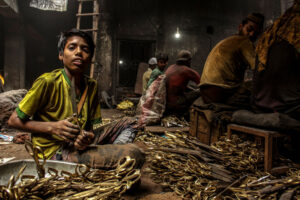

Public relations is the process of managing perceptions. We all engage in public relations at some level:
- Polishing up a CV or resume to impress potential employers
- Trying out a new hairstyle
- Picking and choosing pictures and information to post on social media
Public relations jobs are just the same thing writ large. They exist because big corporations, famous individuals, and governments have the same basic needs we all do to be seen in a positive way, to attract the attention we want, and the discourage the attention we don’t want.
The field of public relations is an exciting one, filled with unexpected challenges and opportunities. On top of the day-to-day issues of emerging controversy or branding, there are some big-picture issues confronting the next generations of public relations professionals.
International markets and globalized information saturation – Public relations has to have a keen sense of audience. Who are you trying to reach, and what are their current thoughts on the subject you seek to influence? In an era where the internet reaches every corner of the globe and every individual has an outlet in social media, capturing your audience has new cultural and communication angle that must be mastered.
Shifting media and technology landscapes develop new niches – Everyone has become familiar with the influence of social media in public relations. But it’s just part of a larger shift in the media landscape, driven by technology and conglomerated corporate ownership of media outlets. PR professionals of the future have to negotiate the ethical and access challenges presented by balkanized media and information archipelagoes.
 In 2004, fans of the video game Halo noticed a strange message apparently hidden in the trailer for the sequel: the URL ilovebees.com flickered through the game logo.
In 2004, fans of the video game Halo noticed a strange message apparently hidden in the trailer for the sequel: the URL ilovebees.com flickered through the game logo.
Visitors to the URL found a website that ostensibly had been dedicated to beekeeping and selling honey. But the website seemed corrupted, as if it had been hacked. A plaintive message from the purported webmaster asked for help in figuring out what had happened. Slowly, visitors to the site began to decode some of the site glitches, figuring out eventually that they referred to GPS coordinates and time and date codes… dates from the future.
A visitor to any of those GPS coordinates at the listed time found a ringing pay phone. And on the other end, prerecorded riddles, which the visitor could leave answers to if they had analyzed the website correctly.
The phenomenal went viral quickly, even driving one sleuth to stand in a Burger King parking lot as Hurricane Frances bore down on him, waiting to answer the pay phone there. And as the clues were pieced together, the I Love Bees phenomena was revealed to be an alternate reality game (ARG) developed to publicize Halo 2. It was one of the first of an increasingly elaborate trend toward gamifying public relations in the electronics industry, a trend that is likely to spread to other sectors as the world becomes increasingly wired.
Those big-picture challenges bring PR professionals face-to-face with exactly the kind of intersectional issues that liberal studies excel in addressing. A broad background of knowledge in current events, ethics, history, and culture offers unique tools for handling issues where trends come together to dramatically shift public opinion and behavior. When you never know what sort of tasks the day will bring you, a liberal arts degree is always a good choice to be prepared.
In Any Role, the Public Relations Job Description Will Involve Taking Charge
Here’s the secret about public relations jobs: they can be a lot of fun.
Sure, you will have to field calls from irate people who have ended up on the wrong end of some project or another your company is behind. And there are going to be rough conversations with reporters from time to time while you try to tamp down scandal or sell some new initiative that you desperately need good news coverage about.
But even those little rough spots come with the excitement of not known exactly how your day is going to unfold.
A job in public relations means that you will wake up every morning with the possibility of finding something entirely new to manage.

Your company may be releasing a new product soon; your boss wants glowing reviews on the cover of every major industry magazine. That means you are on the phone and texting all your contacts at those publications to try to line up a positive review and story. When the writer is assigned, you’re also going to be the one pitching all the positive elements of the product and downplaying any deficiencies, armed with fact sheets and an expense account for wining and dining.
Or you might get hit with the downside of the manufacturing business after the product comes out: a factory where it was made has been found to use underage child labor, working for pennies in brutal conditions. Guess who gets to field the irate phone calls from legislators and human rights groups the next day? And beyond that, you will spin the story to highlight positive aspects, such as other things the company does for those communities, comparable conditions at plants for your competitors, and ways that the organization plans to mitigate and make up for any oversights in contracting.
At higher levels, public relations professionals are intimately involved in crafting the response to those kinds of crises, working with strategic leaders to devise not just statements for release to the media, but also concrete actions that are calculated to diffuse negative effects from the story. Public relations managers also articulate strategies for internal communications, shaping the perspective of employees on their own employer. Some public relations professionals have their own kind of fame as public spokespeople for a corporation or brand.
What Are Public Relations Jobs?
Many companies outsource their PR to specialized firms, or allow their advertising agencies to also handle PR. So a lot of public relations jobs are outsourced to firms that specialize in the field. A talented PR specialist might handle a half-dozen or more different clients, usually within the same industry.
The larger public relations function is one that might be handled by a single person, even on a part-time basis, at a very small organization. On the other hand, major corporations and agencies will have a vast public relations staff, with different specialists taking on different responsibilities as part of the larger job.
If you are searching for public relations and communications jobs using those terms, you might be coming up empty-handed. There are no public relations job titles called public relator or public relationator in the way that people in journalism jobs are called journalists. Instead, public relations is a term that describes a constellation of jobs that have a variety of different titles. Those include:
Publicist – Publicists are responsible for going out and getting the attention of the press. They are often the people behind press releases, but it’s about more than just writing. Building relationships with media outlets, getting stories placed on the strength of personal relationships, and spending a lot of time cold-calling reporters and editors is bread and butter stuff for a publicist.
Public relations specialist – Public relations specialist job descriptions might be the most generic in the field. These jobs can incorporate all the specific functions of other roles along with a host of general PR responsibilities like:
- Market analysis
- Corporate profile management
- Determine advertising and promotion opportunities
- Website management and design
Media manager – Increasingly, this role is listed and function as social media manager. The job, in short, is to provide an expert eye to proof and polish just about every piece of information that a company officially releases. Media managers maintain a consistent voice and tone that helps companies stay on-brand in everything from Instagram captions to how-to articles on their support websites. They also are the direct point of support and interaction for many customers who use social media to reach out to complain, praise, or just seek information on the company or its products.
 Media relations specialist – Although the word media appears in both this and the last title, the two roles couldn’t be further apart. A media relations specialist works with outside media organizations, including news and entertainment companies, to help build and shine up the corporate brand. They also try to manage news stories to reflect favorably on the company. They are expected to have a great sense of the media landscape and maintain relationships with producers and reporters. They might also be responsible for product placement in different venues.
Media relations specialist – Although the word media appears in both this and the last title, the two roles couldn’t be further apart. A media relations specialist works with outside media organizations, including news and entertainment companies, to help build and shine up the corporate brand. They also try to manage news stories to reflect favorably on the company. They are expected to have a great sense of the media landscape and maintain relationships with producers and reporters. They might also be responsible for product placement in different venues.
Spokesperson – Spokesperson is a very specialized PR role that takes a lot of poise and polish. These individuals form the public face of the company or brand, which means they have to reflect all of the positive elements that leaders want the market to see. They have to be able to deliver convincing, authentic, and catchy prepared statements as well as think on their feet to respond to spur of the moment questions from reporters or the public. In this day and age, being photogenic also has a lot to do with being a successful spokesperson.
Within most of those roles there is another hierarchy of management and leadership. Big PR firms or departments in larger corporations may employ all of the roles listed above and more. That means having leaders and organizers who can tie all those PR functions together into a coherent public face, as well as handling all the basic human resources, budgeting, and scheduling functions that every business department requires.
Public relations assistant jobs can also be found in every specialty. As you can imagine, though, their job description is a lot different from a public relations manager job description or a public relations director job description.
The Skills Required in Every Public Relations Job Rest on a Foundation of Liberal Studies
Public relations is a job that a liberal arts education might be the best possible preparation to have. On top of the general problem-solving and critical-thinking skills that help you think on your feet, there are a lot of other pieces that come from a liberal arts degree that the average public relations degree job will benefit from.
Although there are a wide range of roles and responsibilities in public relations, they rely on some of the classic skills found in liberal arts training. When you look at what is a public relations job, really, it comes down to applying skills in these areas:
Research – Diving into marketing and sales data is usually the starting point for any kind of major PR decision. Public relations jobs require someone who is comfortable cracking the books and getting into overlooked pieces of information about consumers and decision-makers.
Psychology – The psychology of interest and need is a critical part of everything from big branding campaigns to tiny little tweaks of corporate logos. A good feel for the crowd and individual thought processes is fine, but today there are many more tools to measure psychological data and better theories to apply than the old Madison Avenue gut check.
Communications – Good luck finding any PR job listing that doesn’t have the phrase “Must have exceptional written and verbal communication skills” in it somewhere. Communications skills are the main tool that every public relations specialist uses to accomplish their goals. Whether it’s inking press releases or threading the needle in an informational interview, your command of vocabulary and delivery needs to be on point.
Relationships – Public relations specialist jobs thrive on relationships. Who you know and how well you know them is critical to building trust and getting a sympathetic ear from press, influencers, or thought leaders.
What Are the Major Industries Where Public Relations Jobs are Found?
Just as there are many different specialties within public relations, there are different areas of focus around different industries.
Advertising and Public Relations Jobs
Public relations is not exactly advertising, but it can certainly involve advertising. Purchased (or earned media, as the industry says) advertisements can be a part of public relations campaigns, seeking to influence public opinion in line with other efforts.
PR specialists need to understand advertising and copywriting processes even if they don’t use them directly, since they can form a significant channel of communications with the public. Even if your agency or client isn’t involved with advertising directly, you may need to understand how public perceptions are being shaped by ads run by competitors, or even through other industries entirely. If you are working in PR for PepsiCo, for example, you’d better be keeping up with ads that Coke is running that may be jamming up your efforts.
Fashion Public Relations Jobs
 Fashion is one of those industries where PR is king. Getting the right exposure on the right individuals is something that sells more wardrobes than any amount of pure advertising work. Fashionistas flock to PR work that allows them to rub shoulders with the beautiful and famous. They have to understand fashion trends and how the clothing industry works. As with all PR professionals, the contents of their contacts list is the biggest tool in their arsenal.
Fashion is one of those industries where PR is king. Getting the right exposure on the right individuals is something that sells more wardrobes than any amount of pure advertising work. Fashionistas flock to PR work that allows them to rub shoulders with the beautiful and famous. They have to understand fashion trends and how the clothing industry works. As with all PR professionals, the contents of their contacts list is the biggest tool in their arsenal.
Because of the glitz and glamour, fashion PR jobs are some of the most competitive to land in the entire industry. You’ll need not only a keen fashion sense and the right contacts, but also experience working in fashion industry magazines or adjacent media sites like entertainment.
Communications Public Relations Jobs
There are many jobs in PR that are listed as communications. In many senses, it’s just another one of the general job descriptions that people use when they are talking about public relations work. But it can also indicate a position that is aimed not just at external audiences but also within companies themselves. It can also mean a PR position that involves less spin and more informational and briefing elements.
For example, big utility companies rarely have PR specialists who are listed as PR specialists. Instead, they have communications departments; utility services don’t have competition to worry about, have significant regulatory restrictions on how they operate and communicate with the public, and generally have to play things a lot more straight and narrow than, say, a Hollywood PR firm.
The same is true of hospitals, government agencies, and other organizations who view PR as a communications channel rather than just unearned advertising exposure.
Sports Public Relations Jobs
Sports PR professionals may work not just for professional or popular amateur sports teams, but also for networks and production companies who primarily carry sporting events or offer sports coverage. They also can work for individual players, dealing with the kind of high-profile incidents and clean-up that those networks love to cover. In less seedy situations, they might instead help players publicize their charity efforts or to gain exposure that could lead to lucrative sponsorships or advertising deals.
There’s also a crossover of sorts between sports and fashion PR, where big-name equipment and clothing manufacturers in sporting goods boost their brand through unearned exposure and being worn by popular athletes. Other PR pros work for retailers that sell sporting goods and the big ticketing sales companies that sell access to events.
Public Relations Jobs in Government
 You might be surprised that government has to market itself. After all, there’s no competition. But in a democracy, public buy-in to government policies and services is important. It can determine the success or failure of those policies, and have a real impact on public welfare and happiness. The classic example comes in the field of public health, where reaching out to vulnerable populations and informing them of the dangers, how to protect themselves, and what to do if they are affected can be matters of life or death. You may even be able to think of some public health crisis in your own lifetime where this has been important.
You might be surprised that government has to market itself. After all, there’s no competition. But in a democracy, public buy-in to government policies and services is important. It can determine the success or failure of those policies, and have a real impact on public welfare and happiness. The classic example comes in the field of public health, where reaching out to vulnerable populations and informing them of the dangers, how to protect themselves, and what to do if they are affected can be matters of life or death. You may even be able to think of some public health crisis in your own lifetime where this has been important.
So PR professional find roles in government service as well. But you’ll also find PR jobs in the private sector that have a goal of marketing to the government. Corporations from Google to Tesla have an interest in certain policies and regulations being passed or not passed. And just like any market, government employees and elected officials are open to the techniques used by PR professionals to build a brand and influence thinking.
How to Become a Public Relations Specialist
Jobs for public relations majors are very accessible, usually requiring only a bachelor’s level of college education. Listings rarely specify a particular major, however. There are many business and communications majors that end up in PR, but really any kind of four-year degree that fosters the right soft skills required in the field is a good choice.
The kind of soft skills that make for excellence in the field of public relations are exactly what people prize liberal arts degrees for in the first place. Up above, we noted four key pieces that every PR job relies on:
- Research
- Psychology
- Communications
- Relationships
Bachelor’s degrees in public relations also include coursework in advertising, business, and strategic thinking.
Some of your best preparations in college for a career in PR might actually be the extracurricular parts. Who would have guessed that putting a major party together could be critical job skill training? But it’s hard to think of better practice for a life in PR than getting your kegger put together and publicizing it so well that half of campus shows up.
Of course, you can polish all the particular skills that go into making that rave an event that people will still be talking about when they are in their forties. While some people come to PR skills naturally, they are all things that can be taught and perfected with the right kind of curriculum.
Public relations degrees exist for exactly this reason, but you’ll see that many of the things they teach line up just as well with a liberal arts degree.
The Education of a Public Relations Professional Thrives in Liberal Arts Core Subjects
It’s not a big jump to see how the classical liberal arts education supports and extends every single one of the skills needed by a prospective PR specialist:
Art and Literature – The massive iceberg of popular culture rests on an even more massive base of artistic and cultural artifacts from history. Liberal arts looks at the long arc of human creativity and gives you insights into the roots of modern attitudes and perspectives you need to build successful PR campaigns.
Social Studies – Of course, modern society is influenced by trends beyond just the arts. Liberal studies dives into social studies that explore the effects of health, wealth, cultural attitudes, politics, and other subjects that sway attitudes and perspectives. It’s all part of understanding what makes your audience tick, explored more deeply than in any public relations degree.
Writing and Grammar – The emphasis on grammar and the written word goes way back in liberal studies. For PR professionals, that offers a kind of polish in their written communication that is often lacking in the modern world. In addition to studying great works as examples of persuasive and effective writing, you’ll get plenty of practice and critique in your own writing skills. By the time you graduate, your press release drafts will impress Shakespeare.
Speech and Rhetoric – PR pros also spend a lot of time spinning and convincing people through face-to-face conversation or speeches. Liberal arts has been working on ways to help hone the art of persuasive speaking ever since Demosthenes stuffed his mouth full of rocks. Today’s coursework in rhetoric isn’t quite that intense, but it will help you become more articulate and skilled in the art of persuasion.
Liberal arts also offers a variety of options in exploring the sciences, philosophy, and ethics, all of which may have varying degrees of usefulness in different industries as a PR professional. And the in-depth, exhaustive exploration of the underlying materials in all these subjects that is required for liberal arts projects and papers.
Public Relations Concentrations Cover Specialties that Can Add to Your Expertise
College is also where you can tailor your studies to specialize in a specific role or industry for public relations. There are many concentrations available to prepare for highly specialized jobs in PR, including:
- Marketing and advertising
- New media/social media
- Non-profit marketing
- Media relations
- International relations
One of the advantages of choosing a liberal arts degree is the flexibility that comes with that package. You’re free to tailor your studies to any combination of courses that fit with the general education requirements of the degree. So you can mix and match from coursework in advertising, in strategic business planning, or international studies.
Do Public Relations Manager Jobs Required a Master’s Degree?
Advancement in the field of public relations is more about accomplishment than education. A managerial or other high-paying position in the field does not typically require a master’s degree.
Still, many senior staff and strategic thinkers in the PR world do go on to earn master’s degrees, either in the field of public relations or in communications. Those programs offer an intensive two-year exploration in some of the more advanced subjects in public relations. Areas that command top-dollar in the marketplace include studies of:
- Social media analytics
- Marketing and public opinion evaluation techniques
- Reputation management strategies
- Entrepreneurship
- Communications strategy
A master’s of arts in liberal studies (MALS) offers another option for advanced studies in public relations, though. These two-year programs offer an unprecedented ability to customize your studies, so they could incorporate any of the areas of study listed above. On top of those specifics, however, MALS degrees are renowned for their interdisciplinary approach to education. That gives you the opportunity to draw on any of the traditional liberal studies focus areas to offer new, innovative ways of looking at communications and PR challenges.
With a Public Relations Job, Salary Prospects Give You a Lot to Get Excited About
Although public relations jobs come with a lot of different job titles out in the real world, the Bureau of Labor Statistics (BLS) makes it easy to get a snapshot of the overall salaries you can expect for all of those jobs. They break down public relations positions into just two categories, one for general PR workers and one at the management level. Each of them has a very solid median salary as of 2020:
- Public relations specialist - $62,810
- Public relations and fundraising managers - $118,430
Public relations work is much more about skill than job titles. The highest paying public relations specialist jobs can pull down as much as managers do, with the top ten percent bringing in more than $118,210.
Of course, highly qualified managers get their own substantial pay bump, with the top ten percent of those pros pocketing more than $208,000 annually. That’s actually as high as the BLS scale goes, so it could be a lot more.
Both categories are also projected to experience faster than average growth over the coming decade, with 11 percent and 13 percent increases in positions respectively.
Entry-Level Public Relations Pay Can Vary in Different Areas and Industries
PR is just more intrinsically valuable in some industries than others. You might not realize it, but BLS ranks the natural gas distribution industry as the third highest paying for PR specialists in the entire country. A lot of money gets spent polishing up the reputation of natural gas pipeline projects!
Sometimes it’s the companies with the worst reputations that will pay the most for a talented public relations specialist.
So the industry where you specialize will have a lot to do with your total compensation. The top five highest paying industries for PR specialists offer salaries well above the median:
- Computer and peripheral manufacturing - $114,370
- Legal services - $100,360
- Natural gas distribution - $99,790
- Federal government - $99,340
- Metal ore mining - $95,930
For managers, the top salaries are just as generous, but the top-paying industries are slightly different:
- Computer and peripheral manufacturing - $205,980
- Couriers and express delivery services - $197,880
- Miscellaneous manufacturing - $183,080
- Cable and subscription programming - $179,510
- Wholesale electronics markets - $176,200
Geography matters, too, even in an age where remote public relations jobs are becoming more common. You can see big swings in this representative sample of median public relations jobs salary levels across the country:
- New York : $79,700
- California : $80,090
- Illinois : $66,120
- Texas : $60,800
- Florida : $58,300
- Missouri : $58,020
- Georgia : $59,560
- Washington : $81,380
The very top rates are found in Washington D.C., where the average PR specialist brings in $109,140 per year.
In fact, public relations might be one of the highest paying fields that a liberal arts graduate can easily get into.
If you’re looking for exciting, high-impact ways to put a liberal arts education to good use, then careers in public relations can offer you opportunities you won’t find in most traditional liberal arts jobs. You’ll use your critical-thinking and problem-solving skills in fast-paced, people-facing work that brings understanding and consensus into the world.
2020 US Bureau of Labor Statistics salary figures and job growth projections for Public Relations Specialists and Public Relations and Fundraising Managers reflect national data not school-specific information. Conditions in your area may vary. Data accessed January 2022.





